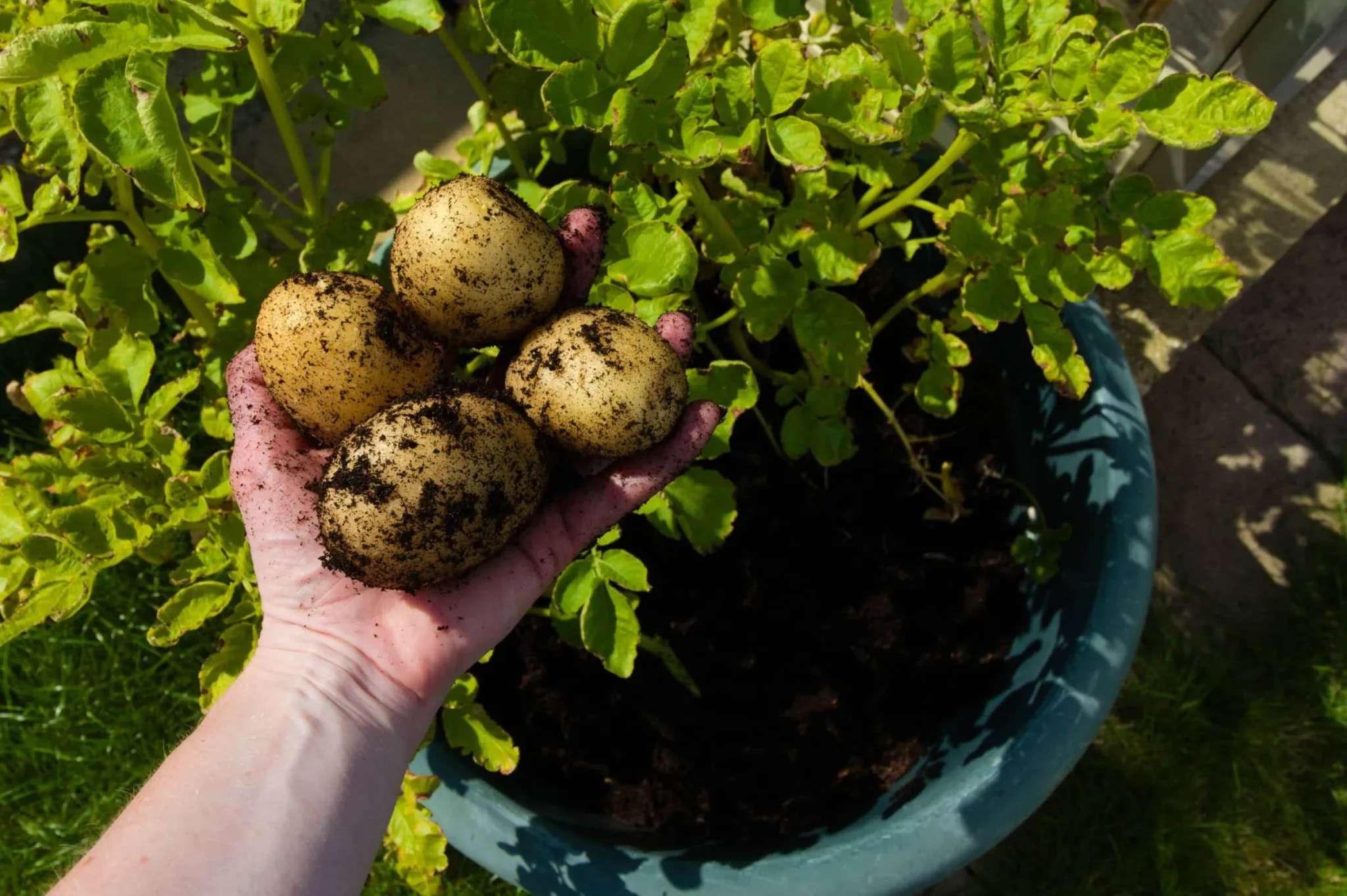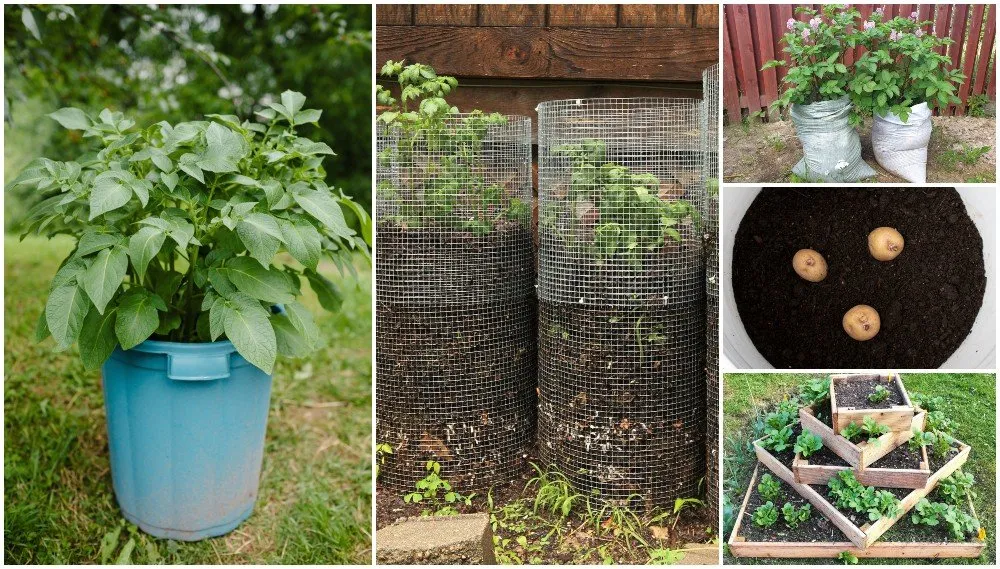Potatoes are a staple in many people’s diets since they can be prepared in so many delicious ways. The fresh and crisp flavor of a potato grown in your own backyard, though, is the real treat. You’ve come to the right place if you’re interested in learning about growing potatoes in containers.
First, you need learn about potato growth before starting a container farm.
Many slightly indentation ‘eyes’ can be found on the potato’s skin. These eyeballs will sprout if the conditions are right, much like a potato in your kitchen.
This seedling will develop into a stalk after it is planted. Above ground, this stem grows into a plant, with any excess energy being sent down to the roots to form tubers. The term “potato” refers to a thicker part of the subterranean stem.

Choose the best potato variety for your growing conditions.
For shorter growing seasons, like the low desert of Arizona, determinate “early” and “mid-season” potato cultivars are preferred. Rapidly maturing (60-90 days) but producing a lower harvest than indeterminate cultivars, determinate potatoes mature much more quickly. The Yukon Gold, the Purple Viking, and the All Red are just a few examples.
Indeterminate (“late season”) potato cultivars are best for regions with a prolonged growing season. These potatoes take between 110 and 135 days to mature, but the larger harvest is worth the wait because of the numerous layers along the stem. Until they are harvested or killed by cold, indeterminate varieties will keep producing new potatoes all along the stem. You can’t go wrong with any of these ambiguous choices: Russian Blue, Canela Russet, or Ramona.
For the best results, shop for seed potatoes online or at a gardening center that has been certified to sell only disease-free varieties.
Prepare the potato soil for planting.
Seed potatoes should be kept in a warm, sunny location where the temperature stays between 60 and 70 degrees Fahrenheit. This encourages the ‘chitting’ of potatoes, which is the first step in the sprouting process. If the sprouted potatoes are bigger than an egg, cut them into chunks once they have matured and make sure that each piece has between two and three eyes.
4. Plant potatoes at the optimal time of year
Plant potatoes immediately following the last expected frost date in cooler climates. Planting in Arizona’s low desert might take place between September and January.

As a frost-sensitive plant, potatoes won’t survive a severe frost. If frost kills your plants, pick your potatoes as soon as possible, no matter how big they are, to avoid deterioration.
Five tips for growing potatoes in pots. Pick a container that will do the job
Potatoes may be grown in just about any kind of container. You can use either a garbage can, a compost bag, or a burlap bag. The use of 40-gallon grow bags is highly recommended for cultivating potatoes. If you follow the basic planting techniques described below, you will have successful results in any container.
Plant six times as many potatoes as will fit in your container.
It is essential to match the number of seed potatoes to the size of the container while growing in containers. Each potato plant, on average, needs about 3 gallons of space to flourish. Smaller potatoes are a possible outcome of overcrowding.
7. Properly sowing potato seeds
Put some loose soil that has been strengthened with compost at the bottom of the container, at least 3 to 4 inches deep. (The edges of the container can be folded down if desired). In somewhat acidic soil, potatoes can flourish. Follow the recommendations on the fertilizer’s packaging to add acid to your soil, or use a soil mix designed for acid-loving plants.
Cover the seed potatoes with an additional 2 to 3 inches of soil and plant them in the ground, sprouted side up.
When potato shoots are about 6 inches tall, you should partially cover them. This process should be repeated until the plant reaches the top of the container, at which time it can be left uncovered to continue growing.

Hilling potatoes helps indeterminate kinds produce more fruit by shielding them from sunlight that would cause determinates to turn green.
Don’t let the potatoes dry out
For potatoes to thrive, moisture must be constant. Container-grown potatoes need you to give them with hydration all the time, but ground-grown potatoes can find water in the soil around them.
A drip line might be connected into each plant bag to ensure even watering. Soil should be kept consistently moist, but not drenched. Space out your waterings to give the soil a chance to dry out.
Add an organic fertilizer or seaweed extract that thrives in acidic soil to your actively growing potatoes every time you add more soil (or at least twice during the growing season). Water can be conserved by using a straw layer.
9. Put your container in the best possible spot
To develop properly, potatoes require at least six hours of sunshine per day. Planting potatoes in the low desert in the fall requires full sun. Planting potatoes in the spring requires some protection from the sun in the afternoon so they don’t dry out too quickly.
10. Recognize the optimal times for growing and harvesting potatoes “New potatoes” are unripe potatoes that have not yet reached their full size.
Check potatoes after 60–90 days after planting for determinate kinds and 100–120 days after planting for indeterminate varieties. To determine the size of the potatoes, you can use your hand to feel around the base of a stem. Collect the potatoes that have grown to an edible size.
If your preferred potato variety flowers, you can pick ‘fresh’ potatoes right after the blooms fade. Wait until the tops turn yellow and wilt for larger potatoes.
Allowing potatoes to stay in the ground for an extra 2 weeks after the plants die back increases their storage life.
Carefully empty the container into a wheelbarrow when you’re ready to harvest all of the potatoes. Potatoes need to cure for a few hours in the fresh air. The potatoes should be stored in a cool, dry area after being brushed to remove any stray soil.
Within a few weeks following harvest, fresh potatoes are at their peak flavor. Mature, imperfect-free potatoes will keep for a longer period of time in storage.

